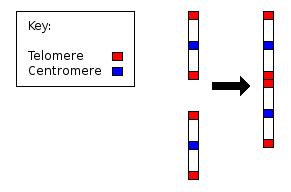Chromosome 2 (human)

Please Take Over This Page and Apply to be Editor-In-Chief for this topic: There can be one or more than one Editor-In-Chief. You may also apply to be an Associate Editor-In-Chief of one of the subtopics below. Please mail us [1] to indicate your interest in serving either as an Editor-In-Chief of the entire topic or as an Associate Editor-In-Chief for a subtopic. Please be sure to attach your CV and or biographical sketch.
Overview
Chromosome 2 is one of the 23 pairs of chromosomes in humans. People normally have two copies of this chromosome. Chromosome 2 is the second largest human chromosome, spanning more than 237 million base pairs [1] (the building material of DNA) and representing almost 8% of the total DNA in cells.
Identifying genes on each chromosome is an active area of genetic research. Because researchers use different approaches to predict the number of genes on each chromosome, the estimated number of genes varies. Chromosome 2 likely contains between 1,300 and 1,800 genes, including those of the HOXD homeobox gene cluster.
Evolution
Chromosome 2 is widely accepted to be a result of a fusion of two ancestral chromosomes. [2] The evidence for this includes:
- The correspondence of chromosome 2 to two ape chromosomes. The closest human relative, the chimpanzee, has near-identical DNA sequences to human chromosome 2, but they are found in two separate chromosomes. The same is true of the more distant gorilla and orangutan. [3][4]
- The presence of a vestigial centromere. Normally a chromosome has just one centromere, but in chromosome 2 we see remnants of a second. [5]
- The presence of vestigial telomeres. These are normally found only at the ends of a chromosome, but in chromosome 2 we see additional telomere sequences in the middle. [6]
Chromosome 2 is thus strong evidence in favour of the common descent of humans and other apes. According to researcher J. W. IJdo:
- We conclude that the locus cloned in cosmids c8.1 and c29B is the relic of an ancient telomere-telomere fusion and marks the point at which two ancestral ape chromosomes fused to give rise to human chromosome 2.
Genes
The following genes are located on chromosome 2:
- ABCA12: ATP-binding cassette, sub-family A (ABC1), member 12
- ABCG5 and ABCG8: ATP-binding cassette, subfamily A, members 5 and 8
- AGXT: alanine-glyoxylate aminotransferase (oxalosis I; hyperoxaluria I; glycolicaciduria; serine-pyruvate aminotransferase)
- ALMS1: Alstrom syndrome 1
- ALS2: amyotrophic lateral sclerosis 2 (juvenile)
- BMPR2: bone morphogenetic protein receptor, type II (serine/threonine kinase)
- COL3A1: collagen, type III, alpha 1 (Ehlers-Danlos syndrome type IV, autosomal dominant)
- COL4A3: collagen, type IV, alpha 3 (Goodpasture antigen)
- COL4A4: collagen, type IV, alpha 4
- COL5A2: collagen, type V, alpha 2
- HADHA: hydroxyacyl-Coenzyme A dehydrogenase/3-ketoacyl-Coenzyme A thiolase/enoyl-Coenzyme A hydratase (trifunctional protein), alpha subunit
- HADHB: hydroxyacyl-Coenzyme A dehydrogenase/3-ketoacyl-Coenzyme A thiolase/enoyl-Coenzyme A hydratase (trifunctional protein), beta subunit
- MSH2: mutS homolog 2, colon cancer, nonpolyposis type 1 (E. coli)
- MSH6: mutS homolog 6 (E. coli)
- NR4A2: nuclear receptor subfamily 4, group A, member 2
- OTOF: otoferlin
- PAX3: paired box gene 3 (Waardenburg syndrome 1)
- PAX8: paired box gene 8
- SLC40A1: solute carrier family 40 (iron-regulated transporter), member 1
- TPO: thyroid peroxidase
Related diseases & disorders
The following diseases are related to genes located on chromosome 2:
- Alport syndrome
- Alström syndrome
- Amyotrophic lateral sclerosis
- Amyotrophic lateral sclerosis, type 2
- Congenital hypothyroidism
- Ehlers-Danlos syndrome
- Ehlers-Danlos syndrome, classical type
- Ehlers-Danlos syndrome, vascular type
- Harlequin ichthyosis
- Hemochromatosis
- Hemochromatosis, type 4
- Hereditary nonpolyposis colorectal cancer
- Infantile-onset ascending hereditary spastic paralysis
- Juvenile primary lateral sclerosis
- Long-chain 3-hydroxyacyl-coenzyme A dehydrogenase deficiency
- Maturity onset diabetes of the young type 6
- Mitochondrial trifunctional protein deficiency
- Nonsyndromic deafness
- Nonsyndromic deafness, autosomal recessive
- Primary hyperoxaluria
- Primary pulmonary hypertension
- Sitosterolemia (knockout of either ABCG5 or ABCG8)
- Waardenburg syndrome
References
- ↑ Hillier; et al. (2005). "Generation and annotation of the DNA sequences of human chromosomes 2 and 4". Nature. 434 (7034): 724–31. PMID 15815621.
- ↑ Human Chromosome 2 is a fusion of two ancestral chromosomes by Alec MacAndrew; accessed 18 May 2006.
- ↑ Yunis and Prakash (1982). "The origin of man: a chromosomal pictorial legacy". Science. 215: 1525–1530. PMID 7063861.
- ↑ Human and Ape Chromosomes; accessed 8 September 2007.
- ↑ Avarello; et al. (1992). "Evidence for an ancestral alphoid domain on the long arm of human chromosome 2". Human Genetics. 89: 247–9. PMID 1587535.
- ↑ IJdo; et al. (1991). "Origin of human chromosome 2: an ancestral telomere-telomere fusion". Proceedings of the National Academy of Sciences. 88: 9051–5. PMID 1924367.
Template:SIB it:Cromosoma 2 (umano) hu:Humán 2-es kromoszóma no:Kromosom 2 sr:Хромозом 2 (човек)